In Vitro Evaluation of the Antibacterial and Antioxidant Activities of Extracts of Gracilaria gracilis with a View into Its Potential Use as an Additive in Fish Feed
Abstract
:Featured Application
Abstract
1. Introduction
2. Materials and Methods
2.1. Sample Collection and Preparation
2.2. Aqueous and Ethanolic Liquid Extractions
2.3. Antioxidant Activity
2.4. Antimicrobial Susceptibility Test
2.4.1. Bacterial Strains and Growth Conditions
2.4.2. Disk Diffusion Method
2.4.3. Microdilution Method
2.5. Statistical Analysis
3. Results
3.1. Aqueous and Ethanolic Sequential Extracts
3.2. Antioxidant Activities of Ethanolic and Aqueous Extracts
3.3. Antibacterial Activities of Ethanolic and Aqueous Extracts
4. Discussion
5. Conclusions
Author Contributions
Funding
Data Availability Statement
Conflicts of Interest
References
- Araújo, R.; Vázquez Calderón, F.; Sánchez López, J.; Azevedo, I.C.; Bruhn, A.; Fluch, S.; Garcia Tasende, M.; Ghaderiardakani, F.; Ilmjärv, T.; Laurans, M.; et al. Current Status of the Algae Production Industry in Europe: An Emerging Sector of the Blue Bioeconomy. Front. Mar. Sci. 2021, 7, 1–24. [Google Scholar] [CrossRef]
- Leandro, A.; Pereira, L.; Gonçalves, A.M.M. Diverse Applications of Marine Macroalgae. Mar. Drugs 2020, 18, 17. [Google Scholar] [CrossRef] [Green Version]
- Morais, T.; Cotas, J.; Pacheco, D.; Pereira, L. Seaweeds Compounds: An Ecosustainable Source of Cosmetic Ingredients? Cosmetics 2021, 8, 8. [Google Scholar] [CrossRef]
- Abdul Khalil, H.P.S.; Saurabh, C.K.; Tye, Y.Y.; Lai, T.K.; Easa, A.M.; Rosamah, E.; Fazita, M.R.N.; Syakir, M.I.; Adnan, A.S.; Fizree, H.M.; et al. Seaweed Based Sustainable Films and Composites for Food and Pharmaceutical Applications: A Review. Renew. Sustain. Energy Rev. 2017, 77, 353–362. [Google Scholar] [CrossRef]
- Ibañez, E.; Herrero, M.; Mendiola, J.; Castro-Puyana, M. Marine bioactive compounds: Sources, characterization and applications. In Marine Bioactive Compounds: Sources, Characterization and Applications; Hayes, M., Ed.; Springer Science|Business Media: New York, NY, USA, 2012; Volume 9781461412, pp. 1–229. ISBN 9781461412472. [Google Scholar]
- Michalak, I.; Chojnacka, K. Algae as Production Systems of Bioactive Compounds. Eng. Life Sci. 2015, 15, 160–176. [Google Scholar] [CrossRef]
- Misurcová, L. Chemical Composition of Seaweeds. In Handbook of Marine Macroalgae: Biotechnology and Applied Phycology; Kim, S.-K., Ed.; John Wiley & Sons, Ltd.: Chichester, UK, 2011; ISBN 9780470979181. [Google Scholar]
- Francavilla, M.; Franchi, M.; Monteleone, M.; Caroppo, C. The Red Seaweed Gracilaria gracilis as a Multi Products Source. Mar. Drugs 2013, 11, 3754–3776. [Google Scholar] [CrossRef] [Green Version]
- MaCartain, P.; Gill, C.I.R.; Brooks, M.; Campbell, R.; Rowland, I.R. Nutritional Value of Edible Seaweeds. Nutr. Rev. 2007, 65, 535–543. [Google Scholar] [CrossRef]
- Biris-Dorhoi, E.S.; Michiu, D.; Pop, C.R.; Rotar, A.M.; Tofana, M.; Pop, O.L.; Socaci, S.A.; Farcas, A.C. Macroalgae—A Sustainable Source of Chemical Compounds with Biological Activities. Nutrients 2020, 12, 3085. [Google Scholar] [CrossRef]
- Holdt, S.L.; Kraan, S. Bioactive Compounds in Seaweed: Functional Food Applications and Legislation. J. Appl. Phycol. 2011, 23, 543–597. [Google Scholar] [CrossRef]
- Capillo, G.; Sanfilippo, M.; Aliko, V.; Spanò, N.; Gioele, C.; Marilena, S.; Valbona, A.; Nunziacarla, S.; Andrea, S.; Antonio, M. Gracilaria gracilis, Source of Agar: A Short Review. Curr. Org. Chem. 2017, 21, 380–386. [Google Scholar] [CrossRef]
- Martín, L.A.; Rodríguez, M.C.; Matulewicz, M.C.; Fissore, E.N.; Gerschenson, L.N.; Leonardi, P.I. Seasonal Variation in Agar Composition and Properties from Gracilaria gracilis (Gracilariales, Rhodophyta) of the Patagonian Coast of Argentina. Phycol. Res. 2013, 61, 163–171. [Google Scholar] [CrossRef]
- Marinho-Soriano, E.; Bourret, E. Effects of Season on the Yield and Quality of Agar from Gracilaria Species (Gracilariaceae, Rhodophyta). Bioresour. Technol. 2003, 90, 329–333. [Google Scholar] [CrossRef]
- Paiva, L.; Lima, E.; Neto, A.I.; Baptista, J. Seasonal Variability of the Biochemical Composition and Antioxidant Properties of Fucus spiralis at Two Azorean Islands. Mar. Drugs 2018, 16, 248. [Google Scholar] [CrossRef] [Green Version]
- Lourenço-Lopes, C.; Fraga-Corral, M.; Jimenez-Lopez, C.; Pereira, A.G.; Garcia-Oliveira, P.; Carpena, M.; Prieto, M.A.; Simal-Gandara, J. Metabolites from Macroalgae and Its Applications in the Cosmetic Industry: A Circular Economy Approach. Resources 2020, 9, 101. [Google Scholar] [CrossRef]
- Marinho, G.S. Antioxidant Content and Activity of the Seaweed Saccharina latissima: A Seasonal Perspective. Antioxidant 2018, 31, 1343–1354. [Google Scholar] [CrossRef] [Green Version]
- Gomez-Zavaglia, A.; Prieto Lage, M.A.; Jimenez-Lopez, C.; Mejuto, J.C.; Simal-Gandara, J. The Potential of Seaweeds as a Source of Functional Ingredients of Prebiotic and Antioxidant Value. Antioxidants 2019, 8, 406. [Google Scholar] [CrossRef] [Green Version]
- Hafting, J.T.; Craigie, J.S.; Stengel, D.B.; Loureiro, R.R.; Buschmann, A.H.; Yarish, C.; Edwards, M.D.; Critchley, A.T. Prospects, and Challenges for Industrial Production of Seaweed Bioactives. J. Phycol. 2015, 51, 821–837. [Google Scholar] [CrossRef]
- Stengel, D.B.; Walker, J.M.; Connan, S. Natural Products from Marine Algae IN Series Editor, 1st ed.; Stengel, G.B., Connan, S., Eds.; Humana Press: Hertfordshire, UK, 2015; ISBN 9781493926831. [Google Scholar]
- Pérez, M.J.; Falqué, E.; Domínguez, H. Antimicrobial Action of Compounds from Marine Seaweed. Mar. Drugs 2016, 14, 52. [Google Scholar] [CrossRef] [Green Version]
- De Alencar, D.B.; de Carvalho, F.C.T.; Rebouças, R.H.; dos Santos, D.R.; dos Santos Pires-Cavalcante, K.M.; de Lima, R.L.; Baracho, B.M.; Bezerra, R.M.; Viana, F.A.; dos Fernandes Vieira, R.H.S.; et al. Bioactive Extracts of Red Seaweeds Pterocladiella capillacea and Osmundaria obtusiloba (Floridophyceae: Rhodophyta) with Antioxidant and Bacterial Agglutination Potential. Asian Pac. J. Trop. Med. 2016, 9, 372–379. [Google Scholar] [CrossRef]
- Peixoto, M.J.; Salas-Leitón, E.; Pereira, L.F.; Queiroz, A.; Magalhães, F.; Pereira, R.; Abreu, H.; Reis, P.A.; Gonçalves, J.F.M.; de Almeida Ozório, R.O. Role of Dietary Seaweed Supplementation on Growth Performance, Digestive Capacity and Immune and Stress Responsiveness in European Seabass (Dicentrarchus labrax). Aquac. Rep. 2016, 3, 189–197. [Google Scholar] [CrossRef] [Green Version]
- Guaratini, T.; Lopes, N.P.; Marinho-Soriano, E.; Colepicolo, P.; Pinto, E. Antioxidant Activity and Chemical Composition of the Non Polar Fraction of Gracilaria domingensis (Kützing) Sonder Ex Dickie and Gracilaria birdiae (Plastino & Oliveira). Rev. Bras. Farmacogn. 2012, 22, 724–729. [Google Scholar] [CrossRef] [Green Version]
- El Shafay, S.M.; Ali, S.S.; El-Sheekh, M.M. Antimicrobial Activity of Some Seaweeds Species from Red Sea, against Multidrug Resistant Bacteria. Egypt. J. Aquat. Res. 2016, 42, 65–74. [Google Scholar] [CrossRef] [Green Version]
- Alassali, A.; Cybulska, I. Methods for Upstream Extraction and Chemical Characterization of Secondary Metabolites from Algae Biomass. Adv. Tech. Biol. Med. 2015, 4, 1–16. [Google Scholar] [CrossRef] [Green Version]
- Grosso, C.; Valentão, P.; Ferreres, F.; Andrade, P.B. Alternative and Efficient Extraction Methods for Marine-Derived Compounds. Mar. Drugs 2015, 13, 3182–3230. [Google Scholar] [CrossRef] [PubMed] [Green Version]
- Cikos, A.M.; Jokić, S.; Šubarić, D.; Jerković, I. Overview on the Application of Modern Methods for the Extraction of Bioactive Compounds from Marine Macroalgae. Mar. Drugs 2018, 16, 348. [Google Scholar] [CrossRef] [PubMed] [Green Version]
- De Almeida, C.L.F.; De S. Falcão, H.; De M. Lima, G.R.; De A. Montenegro, C.; Lira, N.S.; De Athayde-Filho, P.F.; Rodrigues, L.C.; De Souza, M.d.F.V.; Barbosa-Filho, J.M.; Batista, L.M. Bioactivities from Marine Algae of the Genus Gracilaria. Int. J. Mol. Sci. 2011, 12, 4550–4573. [Google Scholar] [CrossRef] [PubMed]
- Capillo, G.; Savoca, S.; Costa, R.; Sanfilippo, M.; Rizzo, C.; Lo Giudice, A.; Albergamo, A.; Rando, R.; Bartolomeo, G.; Spanò, N.; et al. New Insights into the Culture Method and Antibacterial Potential of Gracilaria gracilis. Mar. Drugs 2018, 16, 492. [Google Scholar] [CrossRef] [PubMed] [Green Version]
- Kasanah, N.; Amelia, W.; Mukminin, A.; Triyanto; Isnansetyo, A. Antibacterial Activity of Indonesian Red Algae Gracilaria edulis against Bacterial Fish Pathogens and Characterization of Active Fractions. Nat. Prod. Res. 2018, 33, 3303–3307. [Google Scholar] [CrossRef] [PubMed]
- Kanjana, K.; Radtanatip, T.; Asuvapongpatana, S.; Withyachumnarnkul, B.; Wongprasert, K. Solvent Extracts of the Red Seaweed Gracilaria fisheri Prevent Vibrio harveyi Infections in the Black Tiger Shrimp Penaeus monodon. Fish Shellfish Immunol. 2011, 30, 389–396. [Google Scholar] [CrossRef]
- Cavallo, R.A.; Acquaviva, M.I.; Stabili, L.; Cecere, E.; Petrocelli, A.; Narracci, M. Antibacterial Activity of Marine Macroalgae against Fish Pathogenic Vibrio Species. Cent. Eur. J. Biol. 2013, 8, 646–653. [Google Scholar] [CrossRef]
- Cavas, L.; Yurdakoc, K. A Comparative Study: Assessment of the Antioxidant System in the Invasive Green Alga Caulerpa racemosa and Some Macrophytes from the Mediterranean. J. Exp. Mar. Biol. Ecol. 2005, 321, 35–41. [Google Scholar] [CrossRef]
- Afonso, C.; Correia, A.P.; Freitas, M.V.; Baptista, T.; Neves, M.; Mouga, T. Seasonal Changes in the Nutritional Composition of Agarophyton vermiculophyllum (Rhodophyta, Gracilariales) from the Center of Portugal. Foods 2021, 10, 1145. [Google Scholar] [CrossRef] [PubMed]
- Chan, P.T.; Matanjun, P.; Yasir, S.M.; Tan, T.S. Antioxidant Activities and Polyphenolics of Various Solvent Extracts of Red Seaweed, Gracilaria changii. J. Appl. Phycol. 2015, 27, 2377–2386. [Google Scholar] [CrossRef]
- Vlachos, V.; Critchley, A.T.; Von Holy, A. Establishment of a Protocol for Testing Antimicrobial Activity in Southern African Macroalgae. Microbios 1996, 88, 115–123. [Google Scholar]
- Duan, X.J.; Zhang, W.W.; Li, X.M.; Wang, B.G. Evaluation of Antioxidant Property of Extract and Fractions Obtained from a Red Alga, Polysiphonia urceolata. Food Chem. 2006, 95, 37–43. [Google Scholar] [CrossRef]
- Singleton, V.L.; Rossi, J.A.J. Colorimetry to Total Phenolics with Phosphomolybdic Acid Reagents. Am. J. Enol. Vitic. 1965, 16, 144–158. [Google Scholar]
- Clinical and Laboratory Standards Institute. Performance Standards for Antimicrobial Disk Susceptibility Tests: Approved Standard, 11th ed.; CLSI document M02-A11: Wayne, PA, USA, 2012; Volume 32, ISBN 1562384856. [Google Scholar]
- Clinical and Laboratory Standards Institute. Methods for Determining Bactericidal Activity of Antimicrobial Agents: Approved Guideline M26-A; CLSI: Wayne, PA, USA, 1999; Volume 19, ISBN 1562383841. [Google Scholar]
- Marino, F.; Di Caro, G.; Gugliandolo, C.; Spanò, A.; Faggio, C.; Genovese, G.; Morabito, M.; Russo, A.; Barreca, D.; Fazio, F.; et al. Preliminary Study on the in vitro and in vivo Effects of Asparagopsis taxiformis Bioactive Phycoderivates on Teleosts. Front. Physiol. 2016, 7, 1–11. [Google Scholar] [CrossRef] [Green Version]
- Kosanić, M.; Ranković, B.; Stanojković, T. Biological Activities of Two Macroalgae from Adriatic Coast of Montenegro. Saudi J. Biol. Sci. 2015, 22, 390–397. [Google Scholar] [CrossRef] [PubMed] [Green Version]
- Morais, T.; Inácio, A.; Coutinho, T.; Ministro, M.; Cotas, J.; Pereira, L.; Bahcevandziev, K. Seaweed Potential in the Animal Feed: A Review. J. Mar. Sci. Eng. 2020, 8, 559. [Google Scholar] [CrossRef]
- Garcia-Vaquero, M.; Hayes, M. Red and Green Macroalgae for Fish and Animal Feed and Human Functional Food Development. Food Rev. Int. 2016, 32, 15–45. [Google Scholar] [CrossRef]
- Miranda, M.; Lopez-Alonso, M.; Garcia-Vaquero, M. Macroalgae for functional feed development: Applications in aquaculture, ruminant and swine feed industries. In Seaweeds: Biodiversity, Environmental Chemistry and Ecological Impacts; Newton, P., Ed.; NOVA Science Publishers: Hauppauge, NY, USA, 2017. [Google Scholar]
- Younis, E.S.M.; Al-Quffail, A.S.; Al-Asgah, N.A.; Abdel-Warith, A.W.A.; Al-Hafedh, Y.S. Effect of Dietary Fish Meal Replacement by Red Algae, Gracilaria arcuata, on Growth Performance and Body Composition of Nile Tilapia Oreochromis Niloticus. Saudi J. Biol. Sci. 2018, 25, 198–203. [Google Scholar] [CrossRef]
- Niu, J.; Chen, X.; Lu, X.; Jiang, S.-G.; Lin, H.-Z.; Liu, Y.-J.; Huang, Z.; Wang, J.; Wang, Y.; Tian, L.-X. Effects of Different Levels of Dietary Wakame (Undaria pinnatifida) on Growth, Immunity and Intestinal Structure of Juvenile Penaeus monodon. Aquaculture 2015, 435, 78–85. [Google Scholar] [CrossRef]
- Wan, A.H.L.; Davies, S.J.; Soler-Vila, A.; Fitzgerald, R.; Johnson, M.P. Macroalgae as a Sustainable Aquafeed Ingredient. Rev. Aquac. 2019, 11, 458–492. [Google Scholar] [CrossRef]
- Sotoudeh, E.; Jafari, M. Effects of Dietary Supplementation with Red Seaweed, Gracilaria pygmaea, on Growth, Carcass Composition and Hematology of Juvenile Rainbow Trout, Oncorhynchus mykiss. Aquac. Int. 2017, 25, 1857–1867. [Google Scholar] [CrossRef]
- Al-Asgah, N.A.; Younis, E.S.M.; Abdel-Warith, A.W.A.; Shamlol, F.S. Evaluation of Red Seaweed Gracilaria arcuata as Dietary Ingredient in African Catfish, Clarias gariepinus. Saudi J. Biol. Sci. 2016, 23, 205–210. [Google Scholar] [CrossRef] [PubMed] [Green Version]
- Afonso, C.; Mouga, T. Seaweeds as Fish Feed Additives. In Seaweeds as Plant Fertilizer, Agricultural Biostimulants and Animal Fodder; Pereira, L., Bahcevandziev, K., Joshi, N., Eds.; CRC Press: Boca Raton, FL, USA, 2019. [Google Scholar]
- EL-Sayed Hussein, E.M.; Ebtehal EL-Sayed Hussein, C.M. Effect of Seaweed Supplemented Diets on Nile Tilapia, Oreochromis niloticus Performance. Int. J. Fish. Aquat. Stud. 2017, 5, 205–210. [Google Scholar]
- Passos, R.; Correia, A.P.; Ferreira, I.; Pires, P.; Pires, D.; Gomes, E.; do Carmo, B.; Santos, P.; Simões, M.; Afonso, C.; et al. Effect on Health Status and Pathogen Resistance of Gilthead Seabream (Sparus aurata) Fed with Diets Supplemented with Gracilaria gracilis. Aquaculture 2021, 531, 735888. [Google Scholar] [CrossRef]
- Lozano Muñoz, I.; Wacyk, J.; Perez, C.; Carrasco, J.; Cortez-San Martin, M. Diets Enriched in Red Seaweed (Pyropia columbina and Gracilaria chilensis) Cryo Concentrates Modulate the Immune-Relevant Gene Encoding the Mx Antiviral Protein in Salmon (Salmo Salar) White Blood Cells. J. Appl. Phycol. 2018, 31, 1415–1424. [Google Scholar] [CrossRef]
- Freitas, M.V.; Mouga, T.; Correia, A.P.; Afonso, C.; Baptista, T. New Insights on the Sporulation, Germination, and Nutritional Profile of Gracilaria gracilis (Rhodophyta) Grown under Controlled Conditions. J. Mar. Sci. Eng. 2021, 9, 562. [Google Scholar] [CrossRef]
- Said, R.B.; Mensi, F.; Majdoub, H.; Said, A.B.; Said, B.B.; Bouraoui, A. Effects of Depth and Initial Fragment Weights of Gracilaria gracilis on the Growth, Agar Yield, Quality, and Biochemical Composition. J. Appl. Phycol. 2018, 30, 2499–2512. [Google Scholar] [CrossRef]
- Mensi, F.; Nasraoui, S.; Bouguerra, S.; Ben Ghedifa, A.; Chalghaf, M. Effect of Lagoon and Sea Water Depth on Gracilaria gracilis Growth and Biochemical Composition in the Northeast of Tunisia. Sci. Rep. 2020, 10, 1–12. [Google Scholar] [CrossRef]
- Inácio, A.C.; Morais, T.; Cotas, J.; Pereira, L.; Bahcevandziev, K. Cultivation of Gracilaria gracilis in an Aquaculture System at Mondego River (Portugal) Estuary Adjacent Terrain. In Proceedings of the 1st International Conference on Water Energy Food and Sustainability (ICoWEFS 2021), Leiria, Portugal, 10–12 May 2021; Springer: Berlin/Heidelberg, Germany, 2021. [Google Scholar]
- Thanigaivel, S.; Chandrasekaran, N.; Mukherjee, A.; Thomas, J. Investigation of Seaweed Extracts as a Source of Treatment against Bacterial Fish Pathogen. Aquaculture 2015, 448, 82–86. [Google Scholar] [CrossRef]
- Thanigaivel, S.; Vidhya Hindu, S.; Vijayakumar, S.; Mukherjee, A.; Chandrasekaran, N.; Thomas, J. Differential Solvent Extraction of Two Seaweeds and Their Efficacy in Controlling Aeromonas salmonicida Infection in Oreochromis mossambicus: A Novel Therapeutic Approach. Aquaculture 2015, 443, 56–64. [Google Scholar] [CrossRef]
- Njiru, C.W.; Makonde, H.M.; Kahindo, J.M.; Matoka, E.O.; Matoka, C.M. Bio-Prospecting of Macro-Algae for Potential Industrial Dyes. Afr. J. Biotechnol. 2018, 17, 804–810. [Google Scholar] [CrossRef]
- Godlewska, K.; Michalak, I.; Tuhy, Ł.; Chojnacka, K. The Influence of Ph of Extracting Water on the Composition of Seaweed Extracts and Their Beneficial Properties on Lepidium sativum. BioMed Res. Int. 2017, 2017, 7248634. [Google Scholar] [CrossRef] [PubMed] [Green Version]
- Santos, S.A.O.; Félix, R.; Pais, A.C.S.; Rocha, S.M.; Silvestre, A.J.D. The Quest for Phenolic Compounds from Macroalgae: A Review of Extraction and Identification Methodologies. Biomolecules 2019, 9, 847. [Google Scholar] [CrossRef] [PubMed] [Green Version]
- Trivedi, N.; Baghel, R.S.; Bothwell, J.; Gupta, V.; Reddy, C.R.K.; Lali, A.M.; Jha, B. An Integrated Process for the Extraction of Fuel and Chemicals from Marine Macroalgal Biomass. Sci. Rep. 2016, 6, 1–8. [Google Scholar] [CrossRef] [Green Version]
- Callejón, M.J.J.; Medina, A.R.; Guillén, S.O.; Grima, E.M.; Moreno, P.A.G.; Cerdán, L.E. Simultaneous Extraction and Fractionation of Lipids from the Microalga Nannochloropsis sp. for the Production of EPA-Rich Polar Lipid Concentrates. J. Appl. Phycol. 2020, 32, 1117–1128. [Google Scholar] [CrossRef] [Green Version]
- Vieira, F.A.; Guilherme, R.J.R.; Neves, M.C.; Abreu, H.; Rodrigues, E.R.O.; Maraschin, M.; Coutinho, J.A.P.; Ventura, S.P.M. Single-Step Extraction of Carotenoids from Brown Macroalgae Using Non-Ionic Surfactants. Sep. Purif. Technol. 2017, 172, 268–276. [Google Scholar] [CrossRef]
- Wahlström, N.; Harrysson, H.; Undeland, I.; Edlund, U. A Strategy for the Sequential Recovery of Biomacromolecules from Red Macroalgae Porphyra umbilicalis Kützing. Ind. Eng. Chem. Res. 2018, 57, 42–53. [Google Scholar] [CrossRef]
- El-Sheekh, M.M.; El-Shenody, R.A.E.K.; Bases, E.A.; El Shafay, S.M. Comparative Assessment of Antioxidant Activity and Biochemical Composition of Four Seaweeds, Rocky Bay of Abu Qir in Alexandria, Egypt. Food Sci. Technol. 2021, 41, 29–40. [Google Scholar] [CrossRef]
- Nunes, N.; Valente, S.; Ferraz, S.; Barreto, M.C.; Pinheiro de Carvalho, M.A.A. Nutraceutical Potential of Asparagopsis taxiformis (Delile) Trevisan Extracts and Assessment of a Downstream Purification Strategy. Heliyon 2018, 4, e00957. [Google Scholar] [CrossRef] [PubMed] [Green Version]
- Farvin, K.H.S.; Jacobsen, C. Phenolic Compounds and Antioxidant Activities of Selected Species of Seaweeds from Danish Coast. Food Chem. 2013, 138, 1670–1681. [Google Scholar] [CrossRef]
- Han, D.; Loukianoff, S.; McLaughlin, L. Oxidative stress indices: Analytical aspects and significance. In Handbook of Oxidants and Antioxidants in Exercise; Sen, C.K., Packer, L., Hänninen, O.O.P., Eds.; Elsevier Science: Amsterdam, The Netherlands, 2000; pp. 433–483. [Google Scholar]
- Cho, M.; Lee, H.S.; Kang, I.J.; Won, M.H.; You, S. Antioxidant Properties of Extract and Fractions from Enteromorpha prolifera, a Type of Green Seaweed. Food Chem. 2011, 127, 999–1006. [Google Scholar] [CrossRef] [PubMed]
- Chakraborty, K.; Joseph, D.; Praveen, N.K. Antioxidant Activities and Phenolic Contents of Three Red Seaweeds (Division: Rhodophyta) Harvested from the Gulf of Mannar of Peninsular India. J. Food Sci. Technol. 2015, 52, 1924–1935. [Google Scholar] [CrossRef] [Green Version]
- Hwang, E.S.; Thi, N. Do Effects of Extraction and Processing Methods on Antioxidant Compound Contents and Radical Scavenging Activities of Laver (Porphyra tenera). Prev. Nutr. Food Sci. 2014, 19, 40–48. [Google Scholar] [CrossRef]
- Makkar, F.; Chakraborty, K. First Report of Dual Cyclooxygenase-2 and 5-Lipoxygenase Inhibitory Halogen Derivatives from the Thallus of Intertidal Seaweed Kappaphycus alvarezii. Med. Chem. Res. 2018, 27, 2331–2340. [Google Scholar] [CrossRef]
- Makkar, F.; Chakraborty, K. Unprecedented Antioxidative Cyclic Ether from the Red Seaweed Kappaphycus alvarezii with Anti-Cyclooxygenase and Lipoxidase Activities. Nat. Prod. Res. 2017, 31, 1131–1141. [Google Scholar] [CrossRef] [PubMed]
- Makkar, F.; Chakraborty, K. Antioxidant and Anti-Inflammatory Oxygenated Meroterpenoids from the Thalli of Red Seaweed Kappaphycus alvarezii. Med. Chem. Res. 2018, 27, 2016–2026. [Google Scholar] [CrossRef]
- Miranda-Delgado, A.; Montoya, M.J.; Paz-Araos, M.; Mellado, M.; Villena, J.; Arancibia, P.; Madrid, A.; Jara-Gutiérrez, C. Antioxidant and Anti-Cancer Activities of Brown and Red Seaweed Extracts from Chilean Coasts. Lat. Am. J. Aquat. Res. 2018, 46, 301–313. [Google Scholar] [CrossRef]
- Souza, B.W.S.; Cerqueira, M.A.; Bourbon, A.I.; Pinheiro, A.C.; Martins, J.T.; Teixeira, J.A.; Coimbra, M.A.; Vicente, A.A. Chemical Characterization and Antioxidant Activity of Sulfated Polysaccharide from the Red Seaweed Gracilaria birdiae. Food Hydrocoll. 2012, 27, 287–292. [Google Scholar] [CrossRef] [Green Version]
- Lozano, I.; Wacyk, J.M.; Carrasco, J.; Cortez-San Martín, M.A. Red Macroalgae Pyropia columbina and Gracilaria chilensis: Sustainable Feed Additive in the Salmo Salar Diet and the Evaluation of Potential Antiviral Activity against Infectious Salmon Anemia Virus. J. Appl. Phycol. 2016, 28, 1343–1351. [Google Scholar] [CrossRef]
- Agra Wijnana, A.P.; Kasanah, N. Triyanto Bioactivity of Red Seaweed Gracilaria arcuata against Aeromonas hydrophila and Vibrio sp. Nat. Prod. J. 2018, 8, 147. [Google Scholar] [CrossRef]
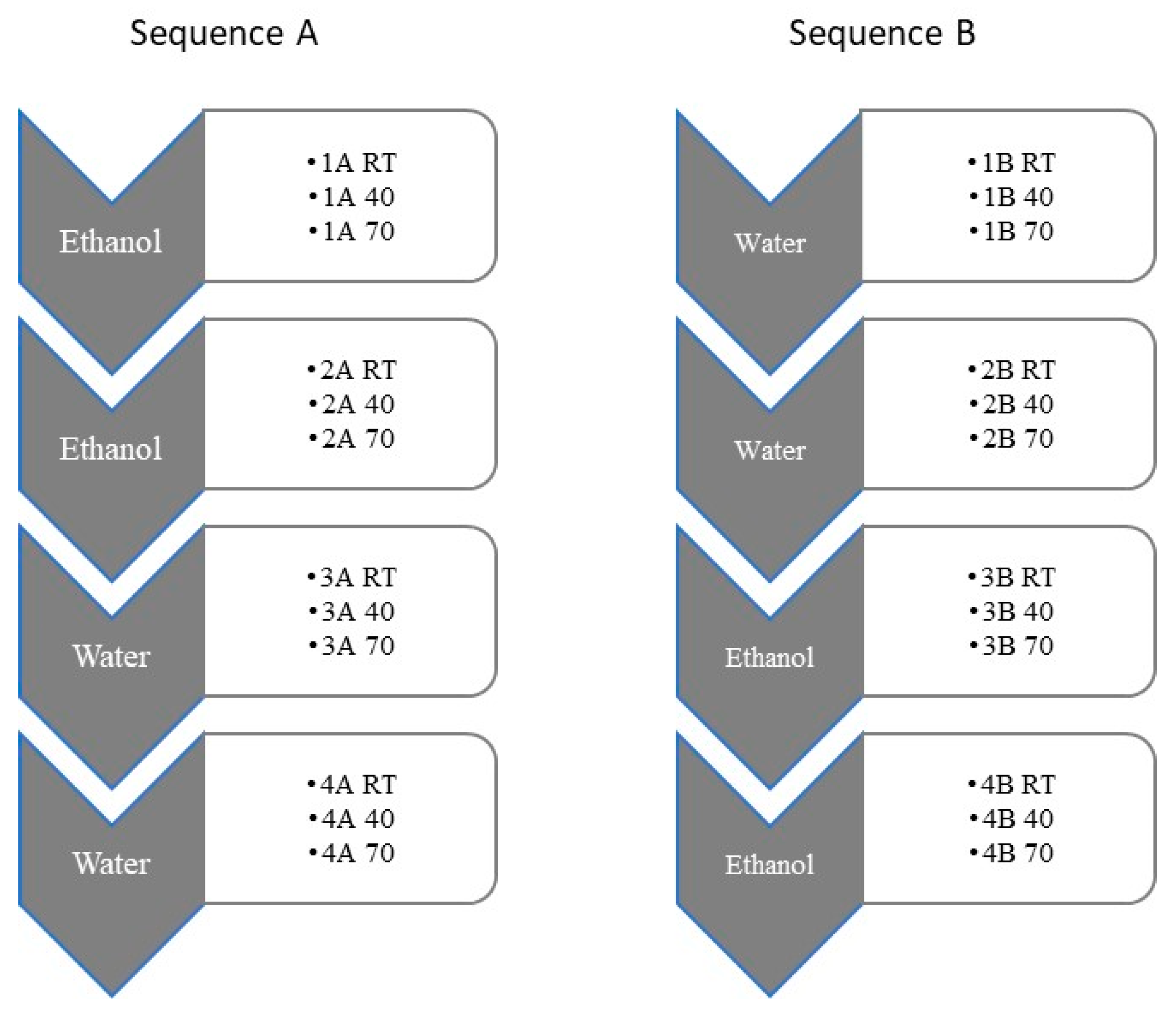
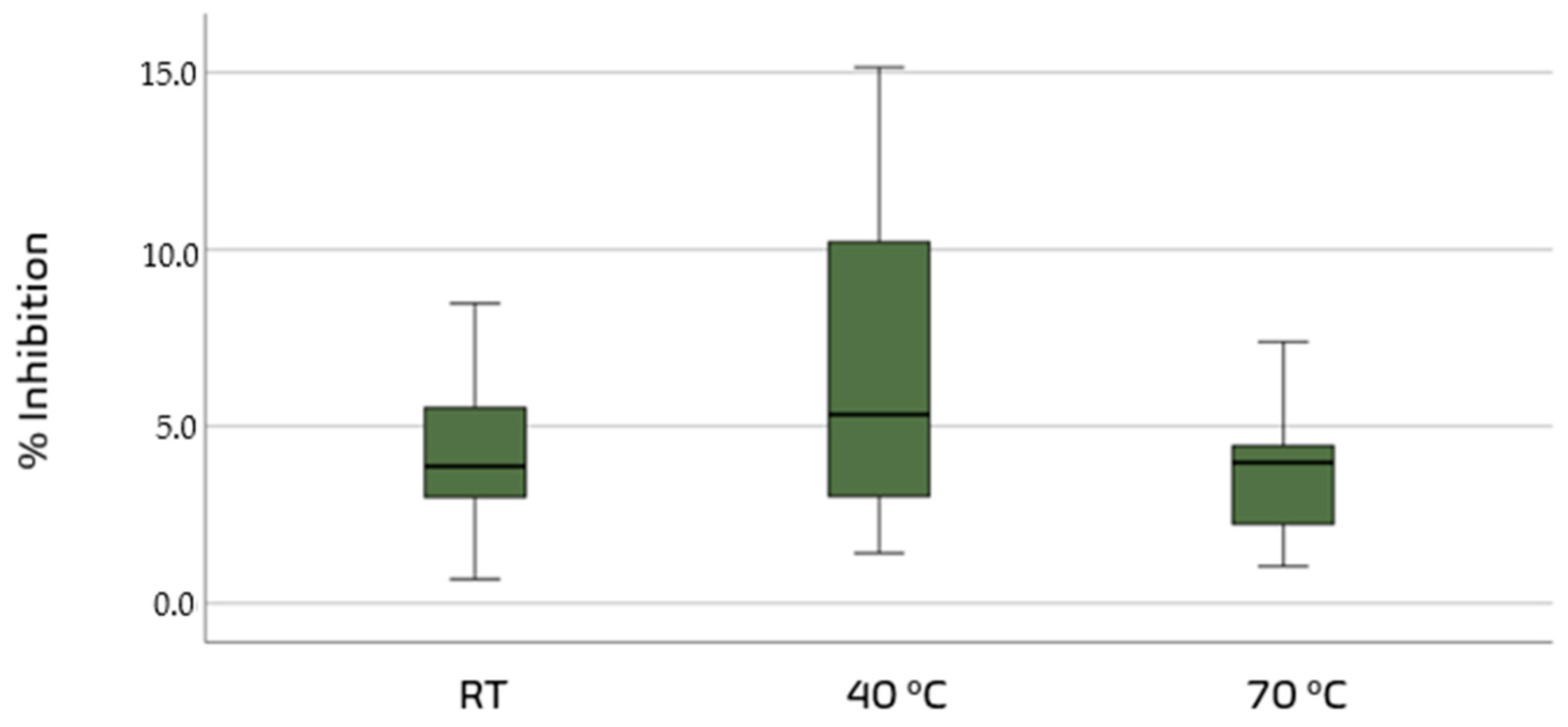
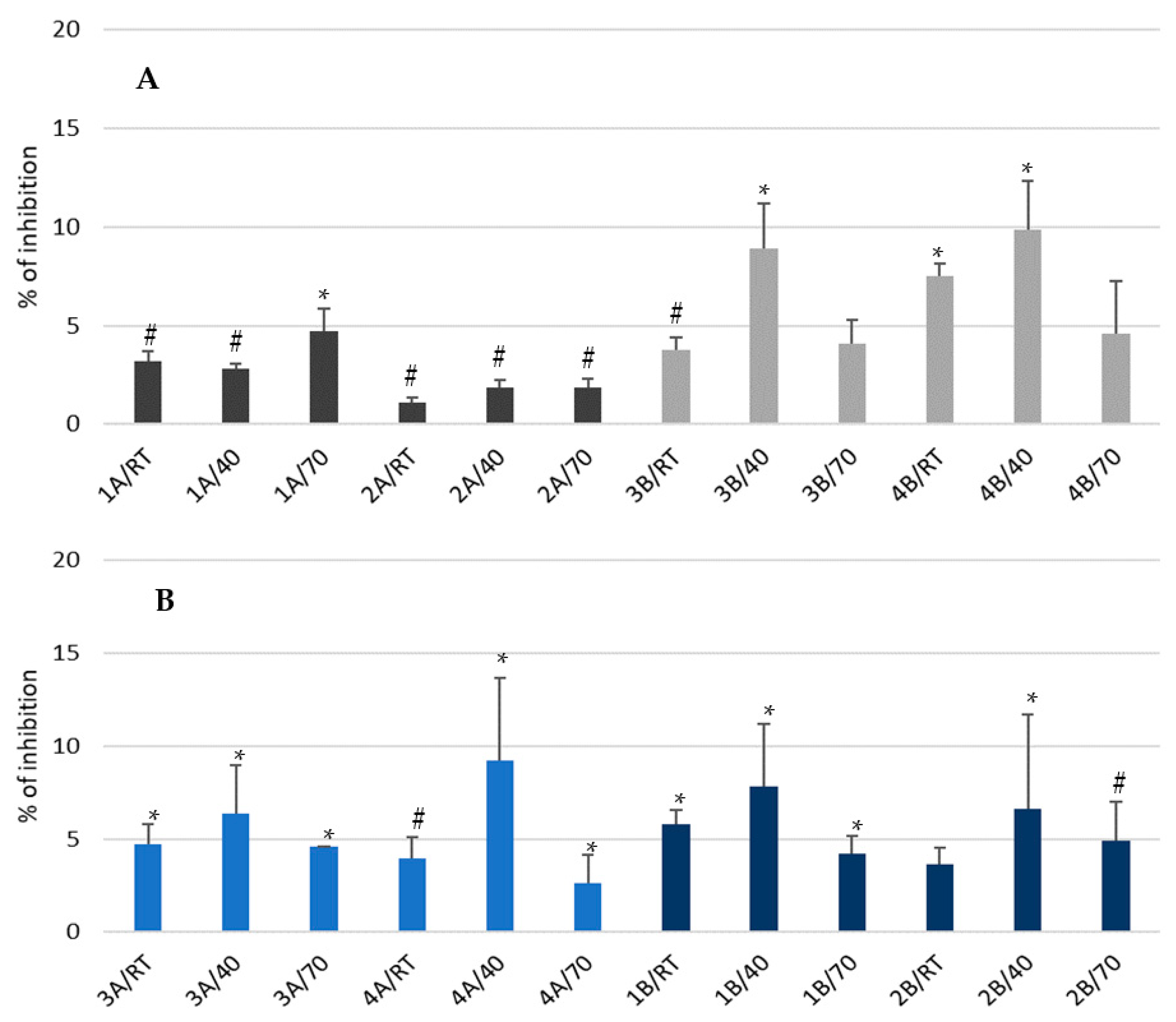
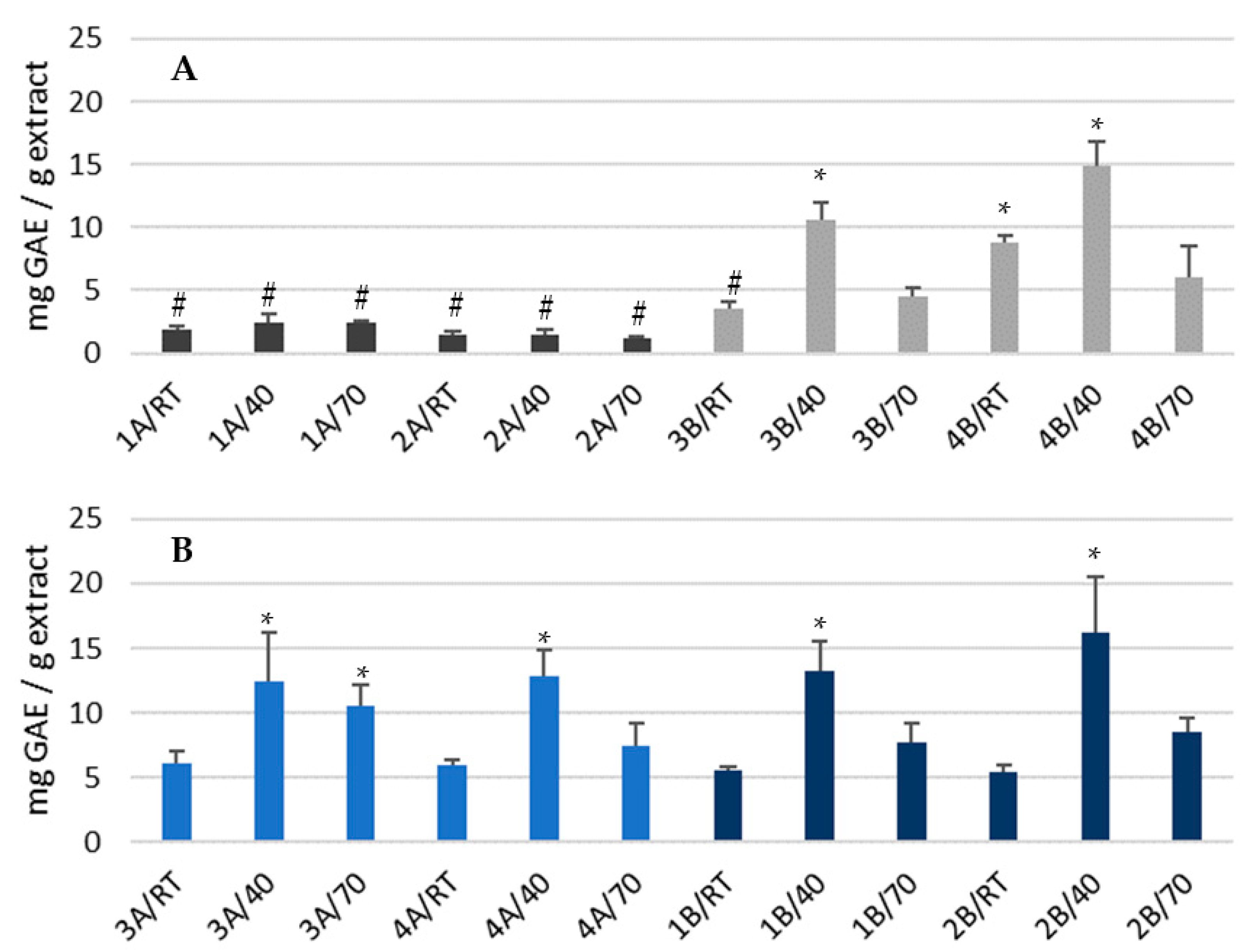
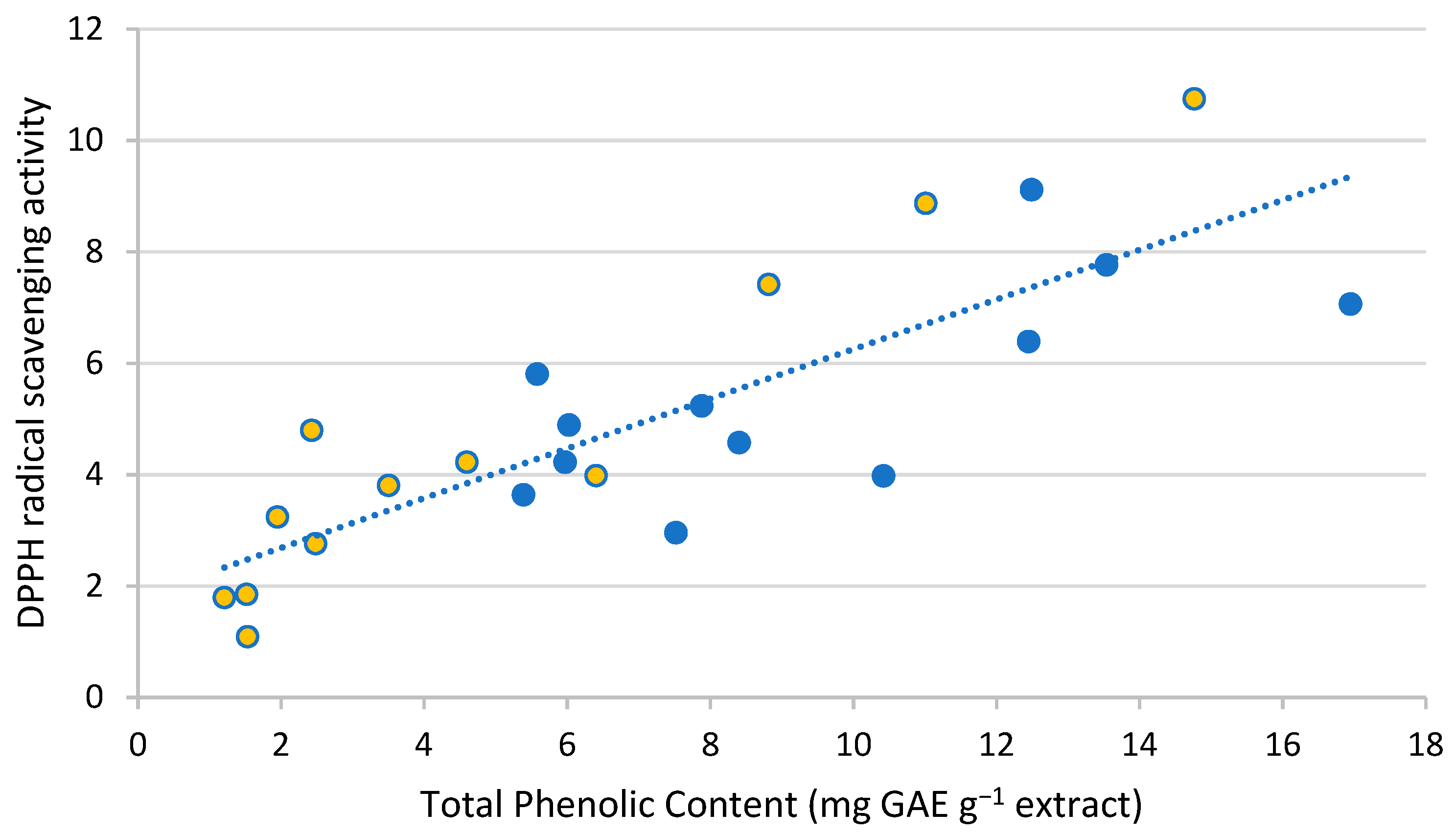
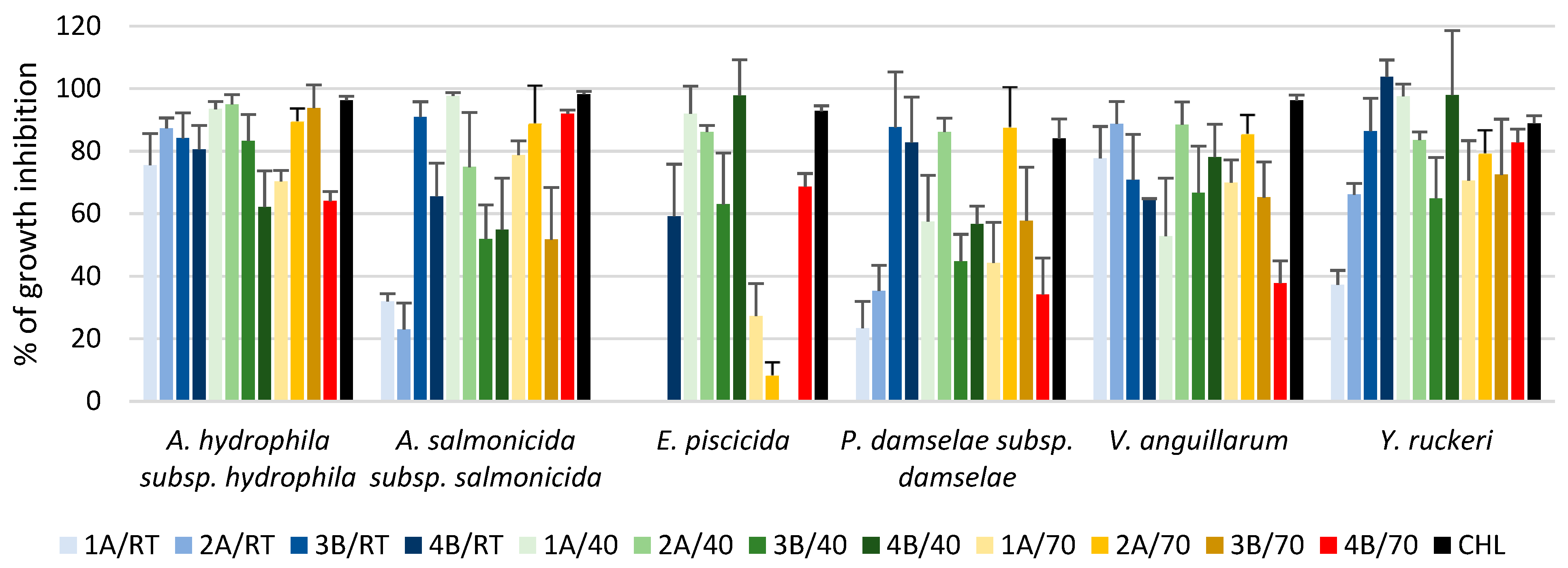
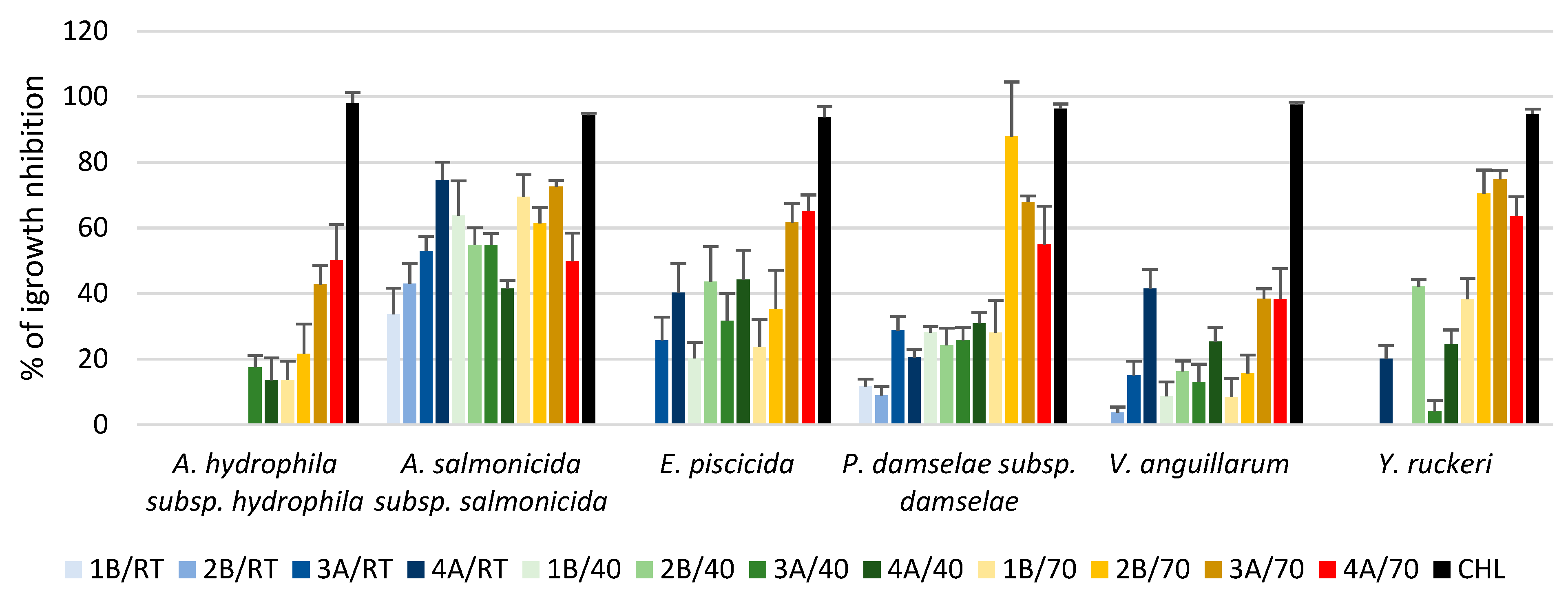
| Extraction Order | Solvent | RT | 40 °C | 70 °C | |
|---|---|---|---|---|---|
| A | 1st | Ethanol | 0.78 ± 0.14 | 1.18 ± 0.25 | 1.20 ± 0.21 |
| 2nd | Ethanol | 0.41 ± 0.09 | 0.46 ± 0.07 | 0.57 ± 0.07 | |
| 3rd | Water | 15.91 ± 1.46 | 16.63 ± 0.74 | 15.65 ± 1.52 | |
| 4th | Water | 6.62 ± 1.03 | 8.94 ± 1.25 | 10.99 ± 1.71 | |
| B | 1st | Water | 15.86 ± 1.14 | 17.03 ± 0.37 | 18.49 ± 1.25 |
| 2nd | Water | 7.75 ± 1.40 | 10.72 ± 0.66 | 10.36 ± 0.40 | |
| 3rd | Ethanol | 2.76 ± 0.55 | 3.46 ± 0.46 | 3.68 ± 1.03 | |
| 4th | Ethanol | 0.68 ± 0.20 | 0.68 ± 0.36 | 0.79 ± 0.19 |
| Strain | 2A | 3B | 4B | CHL |
|---|---|---|---|---|
| Aeromonas hydrophila | - | 8 ± 0.1 | - | 35 ± 0.1 |
| Aeromonas salmonicida | 8 ± 0.1 | 9 ± 0.5 | - | 40 ± 0.1 |
| Edwardsiella piscicida | - | 9 ± 0.1 | - | 40 ± 0.1 |
| Photobacterium damselae | 9 ± 0.1 | 9 ± 0.1 | 8 ± 0.1 | 30 ± 0.1 |
| Vibrio anguillarum | 8 ± 0.1 | 8 ± 0.1 | - | 35 ± 0.1 |
| Yersinia ruckeri | 8 ± 0.1 | 9 ± 0.1 | - | 35 ± 0.1 |
Publisher’s Note: MDPI stays neutral with regard to jurisdictional claims in published maps and institutional affiliations. |
© 2021 by the authors. Licensee MDPI, Basel, Switzerland. This article is an open access article distributed under the terms and conditions of the Creative Commons Attribution (CC BY) license (https://creativecommons.org/licenses/by/4.0/).
Share and Cite
Afonso, C.; Correia, A.P.; Freitas, M.V.; Mouga, T.; Baptista, T. In Vitro Evaluation of the Antibacterial and Antioxidant Activities of Extracts of Gracilaria gracilis with a View into Its Potential Use as an Additive in Fish Feed. Appl. Sci. 2021, 11, 6642. https://doi.org/10.3390/app11146642
Afonso C, Correia AP, Freitas MV, Mouga T, Baptista T. In Vitro Evaluation of the Antibacterial and Antioxidant Activities of Extracts of Gracilaria gracilis with a View into Its Potential Use as an Additive in Fish Feed. Applied Sciences. 2021; 11(14):6642. https://doi.org/10.3390/app11146642
Chicago/Turabian StyleAfonso, Clélia, Ana Patrícia Correia, Marta V. Freitas, Teresa Mouga, and Teresa Baptista. 2021. "In Vitro Evaluation of the Antibacterial and Antioxidant Activities of Extracts of Gracilaria gracilis with a View into Its Potential Use as an Additive in Fish Feed" Applied Sciences 11, no. 14: 6642. https://doi.org/10.3390/app11146642
APA StyleAfonso, C., Correia, A. P., Freitas, M. V., Mouga, T., & Baptista, T. (2021). In Vitro Evaluation of the Antibacterial and Antioxidant Activities of Extracts of Gracilaria gracilis with a View into Its Potential Use as an Additive in Fish Feed. Applied Sciences, 11(14), 6642. https://doi.org/10.3390/app11146642









